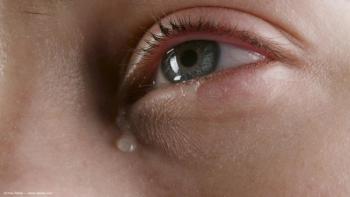
Systemic chemotherapy reduces mortality in retinoblastoma: 30-year analysis from Iran
Key Takeaways
- Systemic chemotherapy has significantly decreased mortality and morbidity in retinoblastoma treatment, while targeted chemotherapy has reduced enucleation rates.
- Historical reliance on enucleation has shifted with systemic and targeted chemotherapy, improving survival and quality of life for retinoblastoma patients.
A study reveals that systemic chemotherapy significantly reduces mortality in retinoblastoma, while targeted treatments lower enucleation rates.
A new study in the International Journal of Retina and Vitreous reported that use of systemic chemotherapy as a mainstay of treatment for retinoblastoma results in significant decreases in mortality and morbidity. Adding targeted chemotherapy reduced the enucleation rates, but, according to the authors, the globe still could not be spared in almost half of patients.1
The study was led by Masood Naseripour, MD, from the Finetech in Medicine Research Center, Iran University of Medical Sciences, and the Department of Ophthalmology, Eye Research Center, The Five Senses Health Institute, Moheb Kowsar Hospital, School of Medicine, Iran University of Medical Sciences, both in Tehran, Iran.
The authors recounted that as late as the 1990s, enucleation was the only option to address the tumor2 and it improved the survival rates.3
Systemic chemotherapy was added during the following decade, but the patients were exposed to toxicity levels of chemotherapy because the tumors were refractory to chemotherapy. Japanese researchers added targeted chemotherapy, including intra-arterial chemotherapy (IAC) and intravitreal injection4 that was later refined by American teams in 2008. This treatment minimized systemic side effects and enhanced efficacy.5,6 These therapeutic advancements, coupled with early detection, have significantly improved survival rates and the quality of life for affected children over decades.7
Because the survival rates after treatments for retinoblastoma have varied across different studies, Dr. Naseripour and colleagues looked back over data obtained during three decades to determine the trends in enucleation and mortality in Iran.
They cited a study from Thailand that reported an upward trajectory in survival rates from 1990 to 2009.8 Another study also showed an increase in 5-year survival rate from 85% to 98% between 1960 and 2022.9 In contrast, other studies showed decreases in retinoblastoma survival rates.10
In the retrospective cohort study under discussion, they divided the years from 1991 to 2018 into the following intervals: T1, pre-2001; T2, 2001-2007; and T3, 2008-2018.
What the retinoblastoma analysis found
Data from 642 eyes were included in this study.
The authors reported, “The incidence of enucleation decreased significantly from T1 to T3 (74%–41%) during the study period (p < 0.001). Pairwise comparisons between T1 and T3 revealed a significant decrease in the incidence of enucleation (74% vs. 41%, p < 0.001). The study also demonstrated a significant reduction in the incidence of enucleation when comparing T2 to T3 (60% vs. 41%, p < 0.001).”
The results also showed that when comparing the time intervals, there was no significant difference between T2 and T3 regarding the incidence of death (4% vs. 1%), but both intervals had statistically significant lower death rates compared with T1 (26%, both p < 0.001).
“It is worth noting that one of the critical factors linked to the survival rate and globe salvage rate in retinoblastoma is the time taken to reach a diagnosis. Delayed diagnosis serves as an indirect measure of awareness regarding retinoblastoma and is heavily influenced by a well-organized healthcare system.11,12 In developing countries, lag time (time to diagnosis interval) is significantly higher than in developed countries; for example, it is 8 weeks in the United Kingdom and 6 weeks in the USA for unilateral Rb compared to 3 to 8 months in India.12-15 Diagnostic delay may cause the relatively advanced age of presentation in developing countries,”16 Dr. Naseripour and colleagues commented.
Based on their results, using systemic chemotherapy led to a noticeable decrease in mortality and morbidity rates in a developing country, and while adding targeted chemotherapy to systemic treatment did not result in higher survival rates, the need for enucleation decreased substantially.
“Finding more effective treatment options with fewer side effects can reduce the burden of the disease and enhance the quality of life in patients with retinoblastoma,” they said.
References
Naseripour M, Aghajani A, Kasraei H, et al. Retinoblastoma survival trend: a 30-year analysis from a referral single center in Iran. Int J Retin Vitr. 2025;11:113.
https://doi.org/10.1186/s40942-025-00702-4 Shields CL, Lally SE. Retinoblastoma. Ocular Oncol. 2019:91–9.
Hilgartner HL. Report of case of double glioma treated with X-Ray. Texas Med J. 1903;18:322–3.
Kaneko A. Chemo-thermotherapy was successful in two cases of recurrence of intraocular retinoblastoma after irradiation. Rinsho Ganka. 1990;44:289–92.
Abramson DH, Dunkel IJ, Brodie SE, Kim JW, Gobin YP. A phase I/II study of direct intraarterial (ophthalmic artery) chemotherapy with Melphalan for intraocular retinoblastoma: initial results. Ophthalmology. 2008;115:1398–404. e1.
Shields CL, Shields JA. Intra-arterial chemotherapy for retinoblastoma: the beginning of a long journey. Clin Exp Ophthalmol. 2010;38:638–43.
Rusakevich AM, Schefler AC. Retinoblastoma: recent trends in diagnosis and management. Curr Surg Rep. 2022;10:51–6.
Wongmas P, Jetsrisuparb A, Komvilaisak P, et al. Incidences, trends and long term outcomes of retinoblastoma in three cancer registries, Thailand. Asian Pac J Cancer Prev. 2015;16:6899–902.
Warda O, Naeem Z, Roelofs KA, Sagoo MS, Reddy MA. Retinoblastoma and vision. Eye. 2023;37:797–808.
Abdelazeem B, Abbas KS, Shehata J, et al. Survival trends for patients with retinoblastoma between 2000 and 2018: what has changed? Cancer Med. 2023;12:6318–24.
Abramson DH, Beaverson K, Sangani P, et al. Screening for retinoblastoma: presenting signs as prognosticators of patient and ocular survival. Pediatrics. 2003;112:1248–1255.
https://doi.org/10.1542/peds.112.6.1248 Chawla B, Hasan F, Azad R, Seth R, Upadhyay AD, Pathy S, et al. Clinical presentation and survival of retinoblastoma in Indian children. Br J Ophthalmol. 2016;100:172–8.
Broaddus E, Topham A, Singh AD. Incidence of retinoblastoma in the USA: 1975–2004. Br J Ophthalmol. 2009;93:21–3.
MacCarthy A, Birch JM, Draper GJ, Hungerford JL, Kingston JE, Kroll ME, et al. Retinoblastoma: treatment and survival in Great Britain 1963 to 2002. Br J Ophthalmol. 2009;93:38–9.
Singh U, Katoch D, Kaur S, Dogra MR, Bansal D, Kapoor R. Retinoblastoma: A sixteen-year review of the presentation, treatment, and outcome from a tertiary care Institute in Northern India. Ocul Oncol Pathol. 2017;4:23–32.
Kumaramanickavel G, Retinoblastoma. An update on clinical, genetic counseling, epidemiology and molecular tumor biology. Books on Demand; 2012.DOI:
10.5772/1301
Newsletter
Don’t miss out—get Ophthalmology Times updates on the latest clinical advancements and expert interviews, straight to your inbox.








































